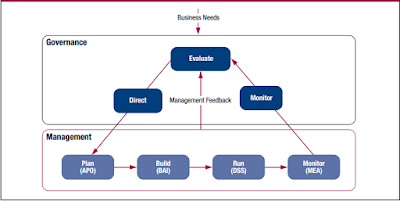Separation between management of a company and the governance policy-makers of a company are essential in avoiding fraud, bribery and corruption; the highest risks associated seen with amalgamation of management and governance policy-makers. Good governance policies keep a company honest and if there were a break down of this separation, management will grow complacent and corrupt (Sun, L., 2016).
According
to the COBIT 5 framework; a business
framework for the governance and management of enterprise IT, principle 5 sets
out the need for separation of management and governance policy-making. The
COBIT 5 includes the following key areas for separation of governance and management as seen in figure 1 and should be adapted to each
individual company (ISACA, 2012). The COBIT 5 Framework can be viewed through the link and should be reviewed to understand governance and management and how they should be adopted within business.
 |
| Figure 1: Governance and Management Key Areas. Adapted from "COBIT 5 A Business Framework for the Governance and Management of Enterprise IT" by ISACA, 2012, p. 32. |
Potential risks relating to not separating management and governance policy-makers is that management (also including lower level employees) are not kept accountable for their actions in making decisions; evaluations of how managers are undertaking business is an important factor of governance. A major example of bad separation of management and governance policy making is the collapse of Enron in 2001.
References:
ISACA. (2012). COBIT 5 A Business Framework for the Governance and Management of Enterprise IT. Retrieved from https://blackboard.qut.edu.au/bbcswebdav/pid-6236971-dt-content-rid-5743722_1/courses/AYB115_16se1/COBIT5-Framework-English.pdf
Sun, L. (2016). Why is Corporate Governance Important? Retrieved from http://www.businessdictionary.com/article/618/why-is-corporate-governance-important/

No comments:
Post a Comment